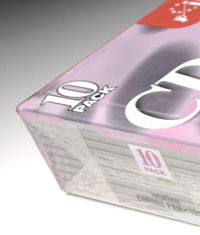Overwrapping
Overwrapping as a term has many different meanings to different people. At its most generic level it refers to the wrapping of any product with a flexible wrapping material, be it aluminium foil, paper, heat sealable film or stretch film. In this way, when applied to machinery or packaging styles, it encompasses many different types of wrapping. Examples of these are L sealing, sleeve wrapping, flow wrapping, four sided sealing or vertical form fill and seal. However, the commonly accepted use of the term overwrapping applies to “tuck and fold” style wrapping.
An overwrapping machine is a packaging machine which automates the hand wrapping process by wrapping a flexible packaging material e.g. paper or heat sealable film, around a rectilinear product or group of products. Envelope style end-folds are characteristic of overwrapping. Different techniques are available for sealing, though typically heat is used to seal film. Paper can be sealed with glue though it may have a heat-sealable plastic coat
Overwrapping fulfills three different functions. Primary wrapping is where the material is in contact with the product, for example a pack of loose playing cards.
Secondary wrapping is where the product has already been packaged using another style of packaging and the overwrap is then added on top, for example a box of chocolates where the cardboard box forms the primary wrap and the overwrap completes the package.
The third function is that of a transit wrap for a collation of loose products, for example a distribution pack of 12 cartons of toothpaste. In this example the overwrapping machine collates the tooth paste cartons and the overwrap keeps the distribution pack togther. Retail multipacks are becoming more common and overwrapping is often used to collate two or three items togther for retail sale, for example a twin pack of biscuits or mint cartons.
There are many different reasons for choosing overwrapping as compared with other forms of packaging. The most important are :
Aroma Control – Overwrapping provides a near hermetic seal and unilike shrink wrapping, which is perforated to allow air to escape during the shrinking process, provides a good barrier preventing cross contamination. Many herbal teas are overwrapped for this reason.
Extended Shelf Life – For the same reasons as above, overwrapping for food and tobacco products can help improve shelf life by preventing bacteria transfer.
Tamper Evidence – Overwrapping can show that a product is intact and has not been contaminated since leaving the factory. This is because one the seal has been broken to extract the product inside, it is very difficult to reseal. In fact, recent contamination of pharmaceutical products in Australia has led to over the counter blister carton products being overwrapped.
Product Appeal – Perhaps the most significant reason for overwrapping is to improve the perceived product quality and value. Cosmetic and perfume products often use a thick film overwrap to provide a “hand wrapped” presentation style to the perfume or cosmetics being sold.
Cost Reduction – Overwrapping with film or paper, especially for collations of products, can actually reduce costs. A thin, lightweight piece of film is less expensive that a complete carton or cardboard outer. For example, many 200s packs of cigarettes are wrapped in film only rather than first being cartonned. In addition, overwrap film is less expensive that polyolefin shrink wrap.
On Pack Promotion – With overwrapping the wrapping film can be printed. This enables marketing and promotional messages to be easily conveyed without the need for labeling or coding. A print registration system mounted on the machine ensures that the print is correctly positioned at all times.
Product Protection – The overwrap forms another barrier around the product and often provides extra strength during transit.
Easy Open – Tear tape system enable the wrap is to be quickly and easily removed without sacrificing product integrity. A thin strip of film, the tear tape, is adhered to the film as the machine is running. A protruding tab then allows the consumer to quickly remove the wrap.
Product Grouping – When a collating system is added to an overwrapper both retail and transit multipacks can be produced.
Packaging & Waste Weight Reduction – Overwrapping, unlike shrinkwrapping, does not waste excess film during wrapping. With new, biodegradable films now becoming available overwrapping packaging waste can simply be composted.
Energy saving – Overwrapping does not use much energy since heat is applied only where the seal is. This means that an overwrapping machine only uses 2 or 3 kilowatts of heat and power whereas sometimes as much as 20 or 30 kilowatts of heat are necessary to power heat shrink tunnels.
Overwrapping has a large amount of relevance today. Whether it is selected from a cost reduction, enhanced security or enhanced product appeal point of view, overwrapping offers tremendous benefits to the packaging of many different products.

